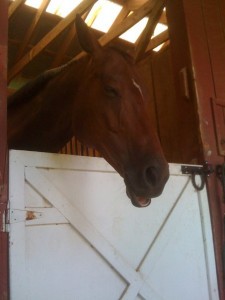You’re at a show, and it’s almost time to warm up for your next class. Butterflies are starting to flap up a storm in your stomach. You glance over at your horse. Is he feeling the excitement?

Nope. He’s standing next to you with eyes closed and head hanging. How could he sleep at a time like this?
A comfortable bed, darkness, privacy, and eight hours of peace and quiet-that’s what you need to sleep well. But your horse’s needs are very different. Knowing about those differences can help you ensure that he gets the rest he needs.
“Horses have sleep patterns typical for prey species that evolved on open plains,” says Sue McDonnell, PhD, head of the Equine Behavior Lab at the University of Pennsylvania’s School of Veterinary Medicine. There isn’t a huge body of research on equine sleep, she notes. But over the past twenty years or so, she’s gathered detailed data on the daily behaviors–including sleep patterns–of stabled and feral horses in a wide range of settings throughout the world. Here, she and two other equine-behavior experts will share their insights–so read on to learn your horse’s sleep secrets…and what he needs to sleep best.
To Sleep, Perchance to Flee
Not every horse falls asleep waiting around at a show, but all horses can sleep standing up. Your horse has a sort of internal hammock-a system of tendons and ligaments called the stay apparatus. This system lets him lock his legs in position so (unlike you) he can relax his muscles and doze off without keeling over. Even when he’s not sleeping, he uses the stay apparatus to rest muscles and reduce fatigue.
Being able to sleep standing up is a great advantage for a prey animal. If a mountain lion comes creeping through the underbrush, the horse can be off and running without wasting precious seconds struggling to his feet. Horses plan for a quick getaway in choosing resting places, too. Out in the open, they go for sheltered areas but position themselves to get out fast–butts to the windbreak, heads pointing toward a likely escape route. “They’re like volunteer firemen who back their cars into parking spaces so they can pull out fast,” Sue McDonnell says. In many cases, even horses in box stalls rest standing toward the back of the stall, facing the door.
Down Time
Even though they’re able to snooze standing, horses apparently need to lie down for rest and sleep at least some of the time. In fact, scientists think horses must lie down to go into deep stages of sleep. Like humans and many other animals, horses experience both slow-wave sleep (SWS) and rapid-eye-movement (REM) deep sleep. (SWS is characterized by slow, synchronized waves of electrical activity in the brain as recorded by electroencephalography. REM sleep is characterized by jerky eye movements and rapid, disorganized brain waves.) REM sleep seems to occur mostly when the horse is stretched out flat on his side, rather than resting on his chest.
People dream during REM sleep, and it seems that horses do, too. Beneath closed lids, their eyes move rapidly back and forth. Sue McDonnell has even seen some horses move their feet as if “trotting” in their dreams. But what horses dream about is anyone’s guess.
See also: Power Naps
This article first appeared in the September 2000 issue of Practical Horseman.









